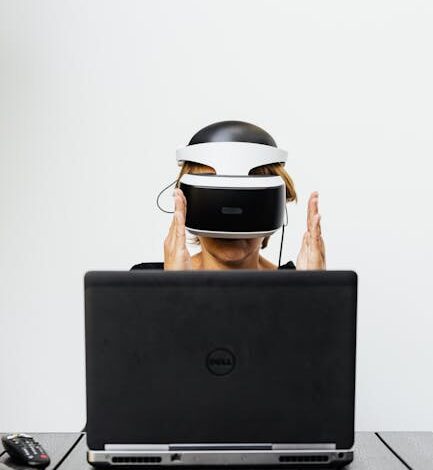How to Choose the Right Gaming Laptop (2025): What You Need to Know

How to Choose the Right Gaming Laptop (2025): What You Need to Know
Estimated Reading Time
Approximately 8-9 minutes.
- Assess your specific gaming and usage needs (casual, competitive, AAA, hybrid) before focusing on technical specifications to ensure the laptop aligns with your lifestyle.
- Prioritize the GPU and its TGP as the most critical factors for gaming performance, complemented by a balanced CPU, at least 16GB DDR5 RAM (32GB for hybrid use), and a 1TB NVMe SSD.
- A robust cooling system is vital for sustained high performance, while a high refresh rate display (1080p/1440p) with good panel technology (IPS/OLED) enhances visual immersion.
- Consider additional features like keyboard quality, port selection, and build durability based on your portability requirements and budget.
- To make an informed decision, define your budget and priorities, conduct thorough research on specific models, and test drive laptops if possible.
- Understanding Your Gaming Needs: More Than Just Specs
- Decoding the Hardware: The Heart of Your Gaming Experience
- Beyond the Core Specs: Features That Enhance Your Play
- Actionable Steps to Your Perfect Gaming Laptop
- Conclusion: Your Ultimate Portable Gaming Experience Awaits
- Frequently Asked Questions (FAQ)
The world of gaming laptops is a thrilling, fast-paced landscape of cutting-edge technology and breathtaking performance. Yet, with every new generation of processors and graphics cards, the decision-making process can feel more overwhelming than ever. By 2025, the options are more diverse and powerful than ever before, promising desktop-level performance in increasingly portable packages.
Whether you’re a casual gamer looking for an upgrade, a competitive esports enthusiast, or a content creator needing a mobile workstation, finding the “perfect” gaming laptop requires careful consideration. It’s not just about raw power; it’s about balance, features, and how well it fits into your unique lifestyle and budget.
With over a decade of experience in reviewing gaming laptops, here’s my rundown of what to consider before pulling the trigger. Let’s cut through the jargon and pinpoint what truly matters, ensuring your investment delivers an unparalleled gaming experience for years to come.
Understanding Your Gaming Needs: More Than Just Specs
Before diving into the intricate world of CPUs and GPUs, take a moment to honestly assess what kind of gamer you are and what you expect from your machine. This fundamental step will guide every subsequent decision.
Are you:
- The Casual Explorer? You enjoy single-player adventures, older titles, or less graphically demanding games. Portability and battery life might be as important as high frame rates.
- The Competitive Pro? Your focus is on esports titles like Valorant, CS2, or League of Legends, where every millisecond counts. High refresh rates and minimal input lag are paramount.
- The AAA Enthusiast? You crave the latest graphically intensive blockbusters at their highest settings. You’ll need top-tier GPUs and vibrant, high-resolution displays.
- The Hybrid User/Content Creator? Beyond gaming, you’ll be streaming, editing videos, rendering 3D models, or doing intensive school/work tasks. This demands a powerful CPU, ample RAM, and potentially a professional-grade display.
Consider where you’ll be gaming most often. Will it be permanently tethered to a desk, or will it travel with you daily? Your answers here will help prioritize aspects like weight, build quality, and battery life over sheer power or vice-versa.
Decoding the Hardware: The Heart of Your Gaming Experience
The internal components are what truly define a gaming laptop’s capabilities. By 2025, expect further refinements and increased efficiency across the board.
The GPU (Graphics Processing Unit): Your Gaming Engine
This is arguably the single most important component for gaming performance. NVIDIA’s GeForce RTX series (likely 50-series or advanced 40-series by 2025) and AMD’s Radeon RX series are the key players. Pay attention to the specific model (e.g., RTX 4070, RTX 5080) and its TGP (Total Graphics Power), which indicates how much power the laptop allows the GPU to draw – higher TGP generally means better performance.
- Entry-Level (e.g., RTX 4050/4060 equivalent): Good for 1080p gaming at moderate settings or esports titles at high frame rates.
- Mid-Range (e.g., RTX 4070/4070 Ti equivalent): Excellent for 1080p high settings and capable 1440p gaming.
- High-End (e.g., RTX 4080/4090 equivalent or 50-series): Designed for 1440p to 4K gaming at max settings, ray tracing, and high frame rates.
Also, consider the amount of VRAM (Video Random Access Memory). 8GB is a reasonable minimum for 2025, but 12GB or more will offer better future-proofing and performance in graphically intensive titles at higher resolutions.
The CPU (Central Processing Unit): The Brains of the Operation
While the GPU handles most of the heavy lifting in gaming, a powerful CPU (Intel Core Ultra series or AMD Ryzen 8000/9000 series) is crucial for frame rate stability, multitasking, and non-gaming tasks like streaming or video editing. Look for models with a good balance of core counts and clock speeds. For pure gaming, a strong mid-range CPU is often sufficient, but for hybrid use, investing in a higher-tier processor pays off.
RAM (Random Access Memory): Smooth Multitasking
For gaming in 2025, 16GB of DDR5 RAM is the absolute minimum you should consider. This allows games to run smoothly alongside background applications. If you plan to stream, edit, or keep many browser tabs open, 32GB of RAM is highly recommended for optimal performance and future-proofing.
Storage: Speed and Capacity
An NVMe SSD is non-negotiable. These solid-state drives offer dramatically faster load times for games and the operating system compared to older SATA SSDs or HDDs. Aim for at least 1TB of NVMe SSD storage. Modern games are massive, and 512GB fills up quickly. Some laptops offer dual SSD slots or a combination of SSD and HDD, which can be useful for storing a large game library or other media.
The Display: Your Window to the Game World
This is where your games come to life. Several factors matter:
- Resolution: 1080p (Full HD) is still excellent for high frame rates, especially on 15-inch screens. 1440p (QHD) offers a sharper image and is increasingly popular for 16-inch and 17-inch laptops. 4K is stunning but very demanding on the GPU and less practical for competitive gaming.
- Refresh Rate: Measured in Hertz (Hz), this indicates how many times the screen refreshes per second. For competitive gaming, 144Hz, 240Hz, or even 360Hz+ is highly desirable. For single-player experiences, 120Hz or 144Hz is perfectly fluid.
- Response Time: Lower is better (e.g., 3ms or less) to reduce motion blur.
- Panel Type: IPS panels offer great color accuracy and viewing angles. OLED displays are becoming more common, offering incredible contrast and vibrant colors, though they can be pricier.
- Adaptive Sync: Look for NVIDIA G-Sync or AMD FreeSync support to eliminate screen tearing and stuttering.
Beyond the Core Specs: Features That Enhance Your Play
A gaming laptop isn’t just a collection of parts; it’s an ecosystem. Don’t overlook these crucial elements:
Cooling System: Sustained Performance is Key
High-performance components generate a lot of heat. A robust cooling system (with multiple fans, heat pipes, and sometimes vapor chambers) is vital to prevent thermal throttling, which can severely reduce performance during long gaming sessions. Read reviews that specifically test thermal performance.
Keyboard and Trackpad: Your Primary Interface
For intense gaming, an external keyboard and mouse are often preferred, but the built-in keyboard quality matters for everyday use. Look for comfortable key travel, anti-ghosting, N-key rollover, and responsive backlighting (often per-key RGB). The trackpad should be precise and smooth, though it won’t be used for serious gaming.
Battery Life: Portability vs. Power
Gaming laptops are not known for their epic battery life, especially when gaming on battery power (which often limits performance). However, for productivity tasks or casual browsing, longer battery life is a huge plus. Expect 4-8 hours for non-gaming use, and significantly less for actual gaming.
Port Selection: Connectivity Matters
Ensure the laptop has the ports you need: USB-A (for peripherals), USB-C (preferably with Thunderbolt 4/5 or USB4 for fast data and external display support), HDMI or DisplayPort for external monitors, Ethernet for stable internet, and a headphone jack. An SD card reader is a bonus for content creators.
Build Quality and Design: Durability and Aesthetics
Gaming laptops range from sleek and understated to aggressive and flashy. Consider the materials used (plastic, aluminum, magnesium alloy) for durability and premium feel. Weight and thickness are also important if portability is a high priority.
Actionable Steps to Your Perfect Gaming Laptop
Step 1: Define Your Budget and Priorities.
Realistically determine how much you can spend. Then, based on your “Understanding Your Gaming Needs” assessment, list your top 3-5 non-negotiable features (e.g., “must have high refresh rate screen,” “needs at least 16GB RAM,” “strongest possible GPU for my budget”). This clarity will narrow down your options significantly.
Step 2: Research and Compare Specific Models.
Once you have a budget and priorities, start looking at laptops within that range. Don’t just look at specs; read comprehensive reviews from reputable tech sites that include benchmarks, thermal tests, and real-world usage scenarios. Compare similar models from different brands (e.g., ASUS ROG, Razer Blade, MSI, Alienware, Lenovo Legion, HP Omen).
Step 3: Test Drive (If Possible).
If you can, visit a local electronics store to get a hands-on feel for laptops you’re considering. Type on the keyboard, check the screen quality, assess the build, and feel the weight. Ergonomics and personal preference play a huge role in daily satisfaction.
Real-World Example: Anya’s Gaming Laptop Quest
Anya is a university student who primarily plays competitive esports titles like Overwatch 2 and Apex Legends, but also needs her laptop for engineering coursework and occasional video editing projects. Her budget is mid-range, around $1500-$2000 USD.
Priorities: High refresh rate 1080p or 1440p display (144Hz+), strong CPU for engineering software, a good mid-range GPU (like an RTX 4070 equivalent for consistent high frames in esports), and at least 16GB RAM (upgradeable to 32GB if possible). Portability is a moderate concern, but cooling is high priority for long study/gaming sessions.
Anya’s Choice: After researching, Anya opted for a Lenovo Legion Pro 5i with an Intel Core i7 (latest generation), RTX 4070, 16GB DDR5 RAM, and a 16-inch 165Hz QHD display. She appreciated its robust cooling, relatively understated design for school, and comfortable keyboard for typing essays. It hit all her key priorities without breaking the bank.
Conclusion: Your Ultimate Portable Gaming Experience Awaits
Choosing the right gaming laptop in 2025 is a personalized journey. By understanding your specific needs, deciphering the technical specifications, and considering the often-overlooked features, you can make an informed decision that will bring countless hours of enjoyment. Remember, the “best” laptop isn’t necessarily the most expensive or powerful, but the one that best suits your gaming style, workflow, and budget.
Take your time, do your research, and don’t be afraid to ask questions. A well-chosen gaming laptop is more than just a piece of hardware; it’s your portal to immersive new worlds and thrilling competitive arenas.
Frequently Asked Questions (FAQ)
Q: What is the most important component for gaming performance in a laptop?
A: The GPU (Graphics Processing Unit) is arguably the most critical component for gaming performance. Its specific model (e.g., NVIDIA RTX 4070) and its TGP (Total Graphics Power) directly determine how well games will run and at what settings/frame rates.
Q: How much RAM is recommended for a gaming laptop in 2025?
A: For gaming in 2025, 16GB of DDR5 RAM is the absolute minimum. However, if you plan on streaming, video editing, or heavy multitasking, 32GB of RAM is highly recommended for optimal performance and future-proofing.
Q: Why is a robust cooling system important for gaming laptops?
A: High-performance components like the CPU and GPU generate significant heat. A robust cooling system (multiple fans, heat pipes, vapor chambers) is crucial to prevent thermal throttling. Without adequate cooling, the components will reduce their performance to avoid overheating, leading to lower frame rates and an inferior gaming experience during extended sessions.
Q: What display features should I look for in a gaming laptop?
A: Key display features include: Resolution (1080p for high frames, 1440p for sharper visuals), a high refresh rate (120Hz, 144Hz, 240Hz+ for smooth motion), low response time (3ms or less), a good panel type (IPS for color, OLED for contrast), and Adaptive Sync (NVIDIA G-Sync or AMD FreeSync) to prevent screen tearing.
Q: How much storage should I aim for in a gaming laptop?
A: You should aim for at least 1TB of NVMe SSD storage. NVMe SSDs offer significantly faster load times compared to older drives. Modern games are very large, and 512GB can fill up very quickly, so 1TB provides better capacity for a decent game library and future titles.





